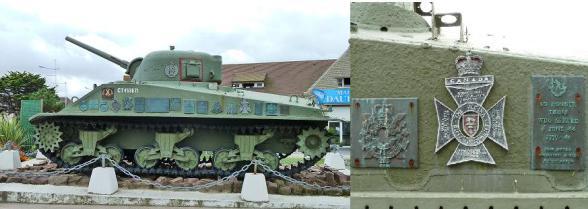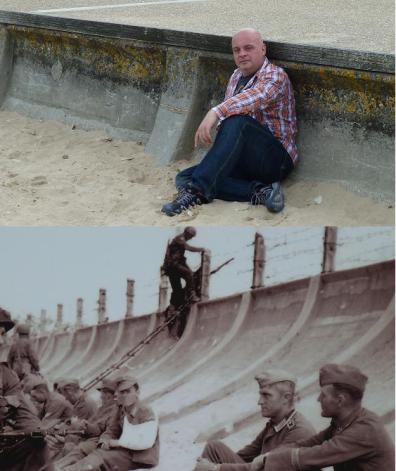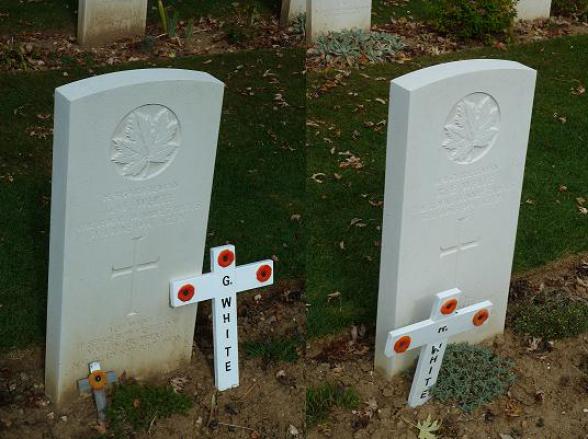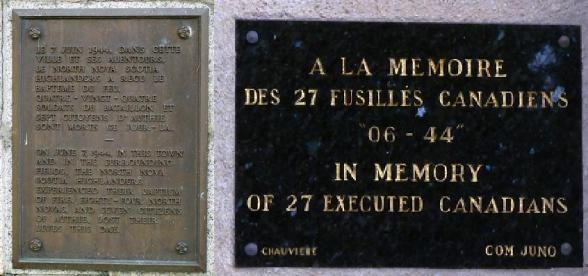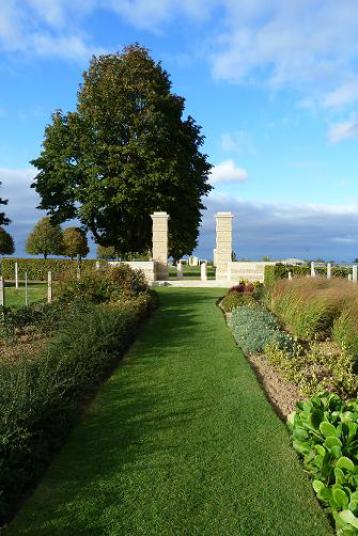
Normandy - Part 4
So again the bells awoke Steve, which sets of
the usual chain reaction, he gets up, gets a shower, smiling to himself of the conversation the night before about the shower gel “Original Source Mint XXX” and the effect that it has on some of the
NMBS’ gentleman’s dangly bits, today Steve played it safe and had some Body shop Tea Tree shower gel. Then he gets dressed and creeps down stairs so it does not disturb the members who managed
to sleep through the bells and puts on the coffee maker. Gerry, Kevin or possibly Lance are usually up next, but a few times for ten minutes, Gerry and Steve sit savouring the coffee, with that
knowing look that “The Wolf” gives to Jimmy in ‘Pulp Fiction’ when Jimmy makes good coffee.
After a fleeting breakfast (very continental, Bread, coffee and yoghurts – but keeping the British end up with the Official NMBS foodstuff, Marmite) we head to the beach where the Canadians landed –
Juno beach. The Canadian advance south on June 6th, 1944 was the furthest inland penetration made of all of the five Allied landing beaches on D-Day. Despite fierce resistance from the German
defenders on the coast and delays owing to the huge traffic jams that developed on the beaches as more and more vehicles and men came ashore, the Canadians overcame their difficulties. However,
although several impromptu solutions to unforeseen problems allowed the Canadian 3rd Infantry Division to push eight and a half miles (12km) south towards their main D-Day objective, the airfield at
Carpiquet, they were still four and a half miles (8km) short when they dug in at nightfall on June 6th.
As the advance south was resumed the following morning the Canadian forces were moving unknowingly into the waiting guns of the 12th SS Hitler Youth Panzer Division who had moved into the line
opposite the Canadians after nightfall on June 6th. The SS counter-attacked and pushed the Canadian's back almost to their June 7th start line. The front line was to advance little towards Carpiquet
from its D-Day position for almost the next five weeks.
Courseulles sur Mer witnessed fierce fighting on
the morning of June 6th, 1944 as the Winnipeg Rifles stormed ashore on the west bank of the river from which the town takes its name. With the Regina Rifles on their left, landing on the east bank of
the river Seulles. Although faced with what they had been told was a third rate German infantry division, lacking everything from motivation to transport, being in strong concrete defensive
emplacements allowed the Germans to fight surprisingly effectively, their lack of transport giving them an otherwise absent tenaciousness as it removed the option of retreat. This led to the
Canadians having to clear out each bunker, one at a time. After wandering around the beach we visited the wonderful Juno beach Centre.
The Juno Beach Centre is a museum and cultural
centre, which opened at Courseulles-sur-Mer, France on June 6, 2003. The Centre presents the war effort made by all Canadians, civilian and military alike, both at home and
on the various fronts during the Second World War, as well as the manifold faces of contemporary Canadian society.
The Juno Beach Centre was established in Canada as a non-profit organization. A Board of Directors based in Burlington,
Ontario runs the Association. The President is Garth Webb, a D-Day veteran. The Juno Beach Centre presents Canada’s role in military operations and the war effort on the home front in World War II.
Film, audio and displays bring pre-war and wartime Canada alive, as well as covering the fighting experiences.
Juno Park at the front of the centre has walkways with interpretation panels, a preserved German bunker and a path leading to the beach. There is little development here, so nothing interrupts your
contemplation of beach and ocean. You can imagine the sands littered with mines-on-sticks, spiky metal “hedgehogs”, barbed wire and other barbarisms intended to rip the heart out of landing craft and
the 14,000 Canadians that landed in this area.
The Minister of Canadian Heritage has designated the Juno Beach landing site to be a site of national historic significance to Canada. Kevin and Steve thought that the museum looked like the Lowry,
The Imperial War Museum (North) and the Guggenheim. And speaking of Steve and Kevin, have a guess that was inside the souvenir shop first and out of the place? And guess who was not touching
fridge magnets this time?
There is a Duplex Drive DD Tank – the DD had a nickname of “Donald Duck” just near the beachfront. This tank was recovered in 1970 from the sea and restored. Badges of regimental units who fought in the area are welded to it. Monuments in the area include the Royal Winnipeg Rifles monument, Regina Rifles Regiment stele, Canadian Scottish Regiment stele, also nearby are the Royal Engineers plaque, and the Liberation and De Gaulle monument. The Croix de Lorraine monument commemorates the return of General de Gaulle in France.
The boys were feeling a wee bit peckish, so some din dins were in order. Croquet Monsieur’s have a place in the NMBS’ heart, but we wanted to try something different. We spotted a place on the harbour at Courseulles sur Mer called Au P'tit Mousse. We sat down and for 9 Euros there was a menu for Moules marinière. They came in all types of recipes – from a Normandie one with Cidre (Kevin had) to a Thai Green Curry one (Steve) to the classic (Stuart, Gerry and Lance) and fair play to the Au P'tit Mousse for 9 Euros they served a large portion of wonderful food. If the NMBS were A.A.Gill (thank god that we aren’t) we would have poncified over it, but to be frank and honest, it was wonderful and possibly one of the best bowls of Moules that we have had. Now fully fuelled – we continued with the rest of the Juno beach area.
Nearby is the small village of Bernieres-sur-Mer. This pretty seaside village is distinguished by its church with a 13th century bell tower and 220-foot spire. La Maison Queen’s Own Rifles of Canada commemorates the men of this regiment. The house is one the famous houses on the beach as it appeared in many news reels and official photos. Memorials to the Queen’s Own Rifles, Le Regiment de la Chaudière and Fort Garry Horse are located by a German bunker at La Place du Canada. There is an excellent view of the beach from the bunker position and you can imagine what it must have been like when 800 men of the Queens’s Own Rifles stormed ashore here as the lead wave of the dramatic D-Day assault.
There are also the North Nova Scotia Highlanders plaque and Journalists HQ plaque. There is a walkway on the seawall that makes for a pleasant stroll along the ocean. If you walk east along the seawall about ½ km, you can see the house that appears in the background on the famous film footage showing the Queen’s Own Rifles of Canada storming the beach on D-Day. Steve did a few comparison picture of now and then.
The opposition the Canadians faced was stronger than that of any other beach
save Omaha. This is sombrely proved at the next place we visited. Beny-sur-Mer Canadian War Cemetery, Reviers is surrounded by the fields where the 3rd Canadian Division fought; this cemetery
contains the graves of 2,044 Canadian soldiers. Heavy casualties were suffered in the fighting inland from Juno, and the majority of the burials here are men from 3rd Canadian Division. Among
them are nine pairs of brothers - a record for a cemetery of the Second World War.
Incredibly, one family had a triple bereavement in Normandy. This was unknown in the British Army, as the practice of placing men from one family together in a unit had largely been discontinued
after the First World War.The Graves of two brothers caught the eye of the NMBS, not because they were more important or brave than the other 2,042 men in the cemetery, but they died on the same day
and had little personal memorials (we assume from the family) with them, the brothers are -
Rfn George WHITE, Royal Winnipeg Rifles, 8.6.44, age 27
Rfn Robert WHITE, Royal Winnipeg Rifles, 8.6.44, age 24
After leaving Beny-sur-Mer, we visited what has become infamous and a dark memory for the Canadians on D-Day. The Murder and massacre of soldiers by the
Nazis. In the first days and weeks after the invasion at Normandy. It is believed that at least 156 Canadian prisoners were executed by hands of the 12th SS Panzer Division 'Hitler Jugend'.
A place in Normandy where such a gruesome act is remembered can be found at the Abbaye d'Ardenne. In this abbey, on the northwest border at Caen, near the village of Cussy (2 kilometres east of
Authie) were at least 20 soldiers murdered. A memorial sign on the wall of the abbey mentions 27 murdered prisoners. At the end of June 6th, 1944, the Canadian unit North Nova Scotia Highlanders,
assisted by the 27th Canadian Armoured Regiment (CAR) The Sherbrooke Fusiliers, had reached Anisy, 8 kilometres north of Caen. The next morning the unit moved further south towards Buron and Authie.
Here they encountered the 12de SS Panzer Division. 37 Canadians were killed, 23 of them after they had lay down their weapons.
The young Germans of the unit refused the locals to bury the victims. The killed Canadian soldiers were overrun by tanks and other vehicles. The Canadians that were taken alive were transferred to
the abbey d'Ardenne. This place filled quickly with prisoners. This was the HQ of SS-Standartenführer Kurt Meyer, commander of the 25th Panzer Grenadier Regiment, 12th SS. When the prisoners were
further transferred to Bretteville-sur-Odon, 11 were picked to stay behind. Of the Highlanders, they were; Private Ivan Crowe, Private Charles Douchette, Corporal Joseph Macintyre, Private Hollis
McKeil (was wounded near Buron) and Private James Moss. Of the 27th CAR were pointed; Trooper George Gill, Trooper Thomas Henry, Trooper James Bolt, Trooper Roger Lockhead, Trooper Harold Philip and
Lieutenant Thomas Windsor. The last four were the crew of the same tank that was put out of action during the fighting. The next day, June 8, the remaining men were brought, one by one, to the small
garden on the west side of the abbey. Within ten minutes the men were murdered.
Meanwhile another seven captured Canadians were brought to the abbey. SS-Standartenführer Kurt Meyer, was exhausted and frustrated of the fighting and the losses he had under his men. The remark that
the prisoners only would eat the few rations the Germans had left was enough to kill these poor men also. After a brief farewell, Private Walter Doherty, Private Reginald Keeping, Private Hugh
MacDonald, Private George McNaughton, Private George Millar, Private Thomas Mont en Private Raymond Moore were shot through the back of the head by an SS Corporal. On June 17, two Canadian soldiers
of the Stormont, Dundas and Glengarry Highlanders, Lieutenant Fred Williams and Lance-corporal George Pollard taken prisoner and brought to the abbey d'Ardenne, never to be seen alive again.
In spite of the Allied advance on Caen, it took them more than a month to liberate the abbey. On July 8, sections of the Regina Rifles marched into the remains. This group found later the lifeless
body of Lieutenant Fred Williams. In September 1944 the family of farmers, who were with the abbey from the twenties, returned. This family, Vico, were during the war with the resistance. They
had gone underground when the Gestapo arrested the father and the mother. Jacques Vico (18) and another brother managed to smuggle the hidden weapons from the abbey before the Gestapo could find
them. In the ruins the family Vico tried to pick up the pieces and start a life anew. When the youngest son, Michel Vico collected some branches from the small garden, he found a jawbone.
In a short time three bodies were exhumed. In the spring of 1945 the other body's are recovered from five shallow graves. Kurt Meyer was taken prisoner by the Americans. He was wearing a Wehrmacht
uniform and managed to hide his true identity for a month. He was transferred to Camp Windermere in England for interrogation.
The witness of the murders at the Abbaye d'Ardenne, de Polish deserter Sturmmann Jan Jesionek brought the allegations to 'Panzermeyer'. Meyer. Meyer was brought to justice in Aurich in Germany.
He denied all the allegations and blamed Schumann (and sent him to the front as punishment). But nobody believed him. Meyer was sentenced to be executed. But the case was reopened and Meyer his
punishment was changed to a lifelong imprisonment, to the disappointment to the Canadians. He spent six years in Canadian jails before he was brought to Germany.
Meyer's sentence to 14 years because of good behaviour. He was released on September 7, 1954. One could think he was now a healed man, but next to his job as a seller of beer, he became an
inspiration on Waffen SS veteran meetings. He worked hard to get a pension for his old army buddy’s (a pension he denied his counterparts the murdered Canadians). Meyer died of a heart attack on
December 23, 1961, he was 51.
The last stop of the day
was at another CWGC at St. Manvieu. Those buried in St. Manvieu War Cemetery died for the most part in the fluctuating battles from mid June to the end of July 1944, in the region between
Tilly-sur-Seulles and Caen.
The cemetery contains 1,627 Commonwealth burials of the Second World War, 49 of them unidentified. There are also 555 German burials. The Day was over and we headed back to another “Quiz
night”, Good food, Chat and a few beers at the Gite. Would the bell ringers get us again?

